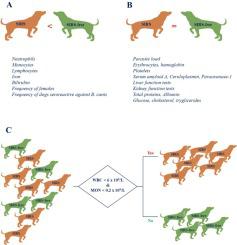Veterinary Parasitology ( IF 2.0 ) Pub Date : 2021-01-19 , DOI: 10.1016/j.vetpar.2021.109366 Anđelo Beletić 1 , Filip Janjić 2 , Milena Radaković 2 , Kristina Spariosu 2 , Jelena Francuski Andrić 2 , Ramaswamy Chandrashekar 3 , Phyllis Tyrrell 3 , Vladimir Radonjić 4 , Bela Balint 5 , Jelena Ajtić 2 , Milica Kovačević Filipović 2

|
The common signs of canine babesiosis caused by an infection with Babesia canis are fever, anorexia, lethargy, pulse alterations, anemia, and occasionally mild icterus. Dogs with these clinical signs can be divided into two groups: those with acute-phase reaction and those with systemic inflammatory response syndrome (SIRS). Factors associated with the occurrence of SIRS in canine babesiosis have not been thoroughly researched. This article outlines a cross-sectional study of 54 client-owned dogs with an acute B. canis infection, and evaluates the differences in age, gender, laboratory findings, parasite load, and seroreactivity against B. canis between the SIRS and the SIRS-free dogs. We have analyzed a complete blood count, serum biochemistry, serum amyloid A, ceruloplasmin, paraoxonase-1, serology, and PCR testing using standard methodologies. The frequency of SIRS among the investigated dogs reached 0.59. Male dogs and those seronegative against B. canis, were more frequent in the SIRS group, whilst age and parasite load could not be associated with the presence of SIRS. Dogs with SIRS had a lower count of total leukocytes, neutrophils, lymphocytes, and monocytes, and a lower concentration of iron and bilirubin compared with SIRS-free dogs. No significant differences in the concentration of acute-phase proteins have been noticed to exist between the groups of dogs. Further, the seronegative dogs had a lower count of lymphocytes and monocytes and a higher parasite load than the seroreactive dogs. Multivariate logistic regression analysis has identified leukopenia (<6 × 109/L) and monocytopenia (<0.2 × 109/L) as independent associates of SIRS in the investigated dogs, thus implying that these routine tests could be used as reliable markers for SIRS.
中文翻译:

犬巴贝斯虫自然感染犬的全身炎症反应综合征:与寄生虫负荷和宿主因素的关联
由犬巴贝斯虫感染引起的犬巴贝斯虫病的常见症状是发烧、厌食、嗜睡、脉搏改变、贫血,偶尔还会出现轻度黄疸。具有这些临床症状的犬可分为两组:急性期反应犬和全身炎症反应综合征(SIRS)犬。与犬巴贝斯虫病 SIRS 发生相关的因素尚未得到彻底研究。本文概述了对 54 只患有急性犬双歧杆菌感染的客户拥有的狗的横断面研究,并评估了年龄、性别、实验室检查结果、寄生虫载量和针对犬双歧杆菌的血清反应性的差异在 SIRS 和没有 SIRS 的狗之间。我们使用标准方法分析了全血细胞计数、血清生化、血清淀粉样蛋白 A、铜蓝蛋白、对氧磷酶-1、血清学和 PCR 检测。被调查犬的SIRS频率达到0.59。公犬和那些对犬双歧杆菌呈血清阴性的犬, 在 SIRS 组中更常见,而年龄和寄生虫负荷与 SIRS 的存在无关。与没有 SIRS 的狗相比,患有 SIRS 的狗的总白细胞、中性粒细胞、淋巴细胞和单核细胞计数较低,铁和胆红素的浓度也较低。已注意到各组狗之间不存在急性期蛋白浓度的显着差异。此外,与血清反应呈阳性的狗相比,血清阴性犬的淋巴细胞和单核细胞数量较少,寄生虫载量较高。多变量逻辑回归分析已确定白细胞减少症 (<6 × 10 9 /L) 和单核细胞减少症(<0.2 × 10 9/L) 作为研究犬中 SIRS 的独立关联者,因此暗示这些常规测试可用作 SIRS 的可靠标记。









































 京公网安备 11010802027423号
京公网安备 11010802027423号